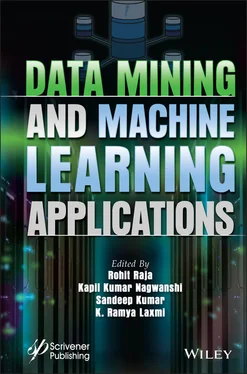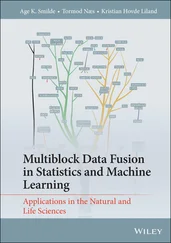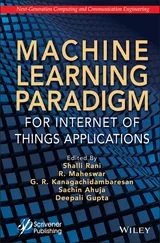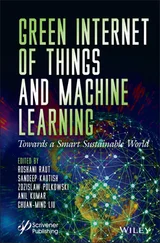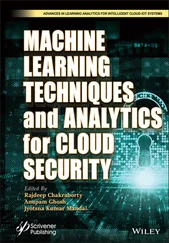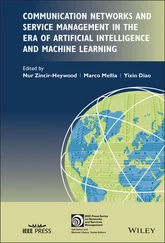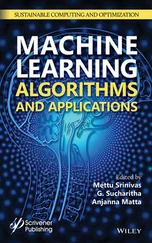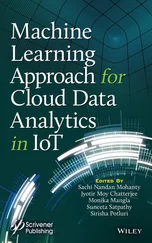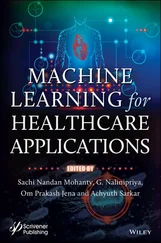Data Mining and Machine Learning Applications
Здесь есть возможность читать онлайн «Data Mining and Machine Learning Applications» — ознакомительный отрывок электронной книги совершенно бесплатно, а после прочтения отрывка купить полную версию. В некоторых случаях можно слушать аудио, скачать через торрент в формате fb2 и присутствует краткое содержание. Жанр: unrecognised, на английском языке. Описание произведения, (предисловие) а так же отзывы посетителей доступны на портале библиотеки ЛибКат.
- Название:Data Mining and Machine Learning Applications
- Автор:
- Жанр:
- Год:неизвестен
- ISBN:нет данных
- Рейтинг книги:3 / 5. Голосов: 1
-
Избранное:Добавить в избранное
- Отзывы:
-
Ваша оценка:
- 60
- 1
- 2
- 3
- 4
- 5
Data Mining and Machine Learning Applications: краткое содержание, описание и аннотация
Предлагаем к чтению аннотацию, описание, краткое содержание или предисловие (зависит от того, что написал сам автор книги «Data Mining and Machine Learning Applications»). Если вы не нашли необходимую информацию о книге — напишите в комментариях, мы постараемся отыскать её.
The book elaborates in detail on the current needs of data mining and machine learning and promotes mutual understanding among research in different disciplines, thus facilitating research development and collaboration.
Audience
Data Mining and Machine Learning Applications — читать онлайн ознакомительный отрывок
Ниже представлен текст книги, разбитый по страницам. Система сохранения места последней прочитанной страницы, позволяет с удобством читать онлайн бесплатно книгу «Data Mining and Machine Learning Applications», без необходимости каждый раз заново искать на чём Вы остановились. Поставьте закладку, и сможете в любой момент перейти на страницу, на которой закончили чтение.
Интервал:
Закладка:
Table of Contents
1 Cover
2 Title Page
3 Copyright
4 Preface
5 1 Introduction to Data Mining 1.1 Introduction 1.2 Knowledge Discovery in Database (KDD) 1.3 Issues in Data Mining 1.4 Data Mining Algorithms 1.5 Data Warehouse 1.6 Data Mining Techniques 1.7 Data Mining Tools References
6 2 Classification and Mining Behavior of Data 2.1 Introduction 2.2 Main Characteristics of Mining Behavioral Data 2.3 Research Method 2.4 Results 2.5 Discussion 2.6 Conclusion References
7 3 A Comparative Overview of Hybrid Recommender Systems: Review, Challenges, and Prospects 3.1 Introduction 3.2 Related Work on Different Recommender System References
8 4 Stream Mining: Introduction, Tools & Techniques and Applications 4.1 Introduction 4.2 Data Reduction: Sampling and Sketching 4.3 Concept Drift 4.4 Stream Mining Operations 4.5 Tools & Techniques 4.6 Applications 4.7 Conclusion References
9 5 Data Mining Tools and Techniques: Clustering Analysis 5.1 Introduction 5.2 Data Mining Task 5.3 Data Mining Algorithms and Methodologies 5.4 Clustering the Nearest Neighbor 5.5 Data Mining Applications 5.6 Materials and Strategies for Document Clustering 5.7 Discussion and Results References
10 6 Data Mining Implementation Process 6.1 Introduction 6.2 Data Mining Historical Trends 6.3 Processes of Data Analysis References
11 7 Predictive Analytics in IT Service Management (ITSM) 7.1 Introduction 7.2 Analytics: An Overview 7.3 Significance of Predictive Analytics in ITSM 7.4 Ticket Analytics: A Case Study 7.5 Conclusion References
12 8 Modified Cross-Sell Model for Telecom Service Providers Using Data Mining Techniques 8.1 Introduction 8.2 Literature Review 8.3 Methodology and Implementation 8.4 Data Partitioning 8.5 Conclusions References
13 9 Inductive Learning Including Decision Tree and Rule Induction Learning 9.1 Introduction 9.2 The Inductive Learning Algorithm (ILA) 9.3 Proposed Algorithms 9.4 Divide & Conquer Algorithm 9.5 Decision Tree Algorithms 9.6 Conclusion and Future Work References
14 10 Data Mining for Cyber-Physical Systems 10.1 Introduction 10.2 Feature Recovering Methodologies 10.3 CPS vs. IT Systems 10.4 Collections, Sources, and Generations of Big Data for CPS 10.5 Spatial Prediction 10.6 Clustering of Big Data 10.7 NoSQL 10.8 Cyber Security and Privacy Big Data 10.9 Smart Grids 10.10 Military Applications 10.11 City Management 10.12 Clinical Applications 10.13 Calamity Events 10.14 Data Streams Clustering by Sensors 10.15 The Flocking Model 10.16 Calculation Depiction 10.17 Initialization 10.18 Representative Maintenance and Clustering 10.19 Results 10.20 Conclusion References
15 11 Developing Decision Making and Risk Mitigation: Using CRISP-Data Mining 11.1 Introduction 11.2 Background 11.3 Methodology of CRISP-DM 11.4 Stage One—Determine Business Objectives 11.5 Stage Two—Data Sympathetic 11.6 Stage Three—Data Preparation 11.7 Stage Four—Modeling 11.8 Stage Five—Evaluation 11.9 Stage Six—Deployment 11.10 Data on ERP Systems 11.11 Usage of CRISP-DM Methodology 11.12 Modeling 11.13 Assessment 11.14 Distribution 11.15 Results and Discussion 11.16 Conclusion References
16 12 Human–Machine Interaction and Visual Data Mining 12.1 Introduction 12.2 Related Researches 12.3 Visual Genes 12.4 Visual Hypotheses 12.5 Visual Strength and Conditioning 12.6 Visual Optimization 12.7 The Vis 09 Model 12.8 Graphic Monitoring and Contact With Human–Computer 12.9 Mining HCI Information Using Inductive Deduction Viewpoint 12.10 Visual Data Mining Methodology 12.11 Machine Learning Algorithms for Hand Gesture Recognition 12.12 Learning 12.13 Detection 12.14 Recognition 12.15 Proposed Methodology for Hand Gesture Recognition 12.16 Result 12.17 Conclusion References
17 13 MSDTrA: A Boosting Based-Transfer Learning Approach for Class Imbalanced Skin Lesion Dataset for Melanoma Detection 13.1 Introduction 13.2 Literature Survey 13.3 Methods and Material 13.4 Experimental Results 13.5 Libraries Used 13.6 Comparing Algorithms Based on Decision Boundaries 13.7 Evaluating Results 13.8 Conclusion References
18 14 New Algorithms and Technologies for Data Mining 14.1 Introduction 14.2 Machine Learning Algorithms 14.3 Supervised Learning 14.4 Unsupervised Learning 14.5 Semi-Supervised Learning 14.6 Regression Algorithms 14.7 Case-Based Algorithms 14.8 Regularization Algorithms 14.9 Decision Tree Algorithms 14.10 Bayesian Algorithms 14.11 Clustering Algorithms 14.12 Association Rule Learning Algorithms 14.13 Artificial Neural Network Algorithms 14.14 Deep Learning Algorithms 14.15 Dimensionality Reduction Algorithms 14.16 Ensemble Algorithms 14.17 Other Machine Learning Algorithms 14.18 Data Mining Assignments 14.19 Data Mining Models 14.20 Non-Parametric & Parametric Models 14.21 Flexible vs. Restrictive Methods 14.22 Unsupervised vs. Supervised Learning 14.23 Data Mining Methods 14.24 Proposed Algorithm 14.25 The Regret of Learning Phase 14.26 Conclusion References
19 15 Classification of EEG Signals for Detection of Epileptic Seizure Using Restricted Boltzmann Machine Classifier 15.1 Introduction 15.2 Related Work 15.3 Material and Methods 15.4 Experimental Framework 15.5 Experimental Results and Discussion 15.6 Discussion 15.7 Conclusion References
20 16 An Enhanced Security of Women and Children Using Machine Learning and Data Mining Techniques 16.1 Introduction 16.2 Related Work 16.3 Issue and Solution 16.4 Selection of Data 16.5 Pre-Preparation Data 16.6 Application Development 16.7 Use Case For The Application 16.8 Conclusion References
21 17 Conclusion and Future Direction in Data Mining and Machine Learning 17.1 Introduction 17.2 Machine Learning 17.3 Conclusion References
22 Index
23 End User License Agreement
List of Illustrations
1 Chapter 1 Figure 1.1 Knowledge discovery in Database—KDD. Figure 1.2 Time series database. Figure 1.3 Data warehouse. Figure 1.4 Decision Tree. Figure 1.5 Installation of KNIME. Figure 1.6 Installation of KNIME (2). Figure 1.7 Setting path for installing KNIME. Figure 1.8 Starting installation of KNIME. Figure 1.9 Selecting directory as a workspace. Figure 1.10 Starting KNIME. Figure 1.11 Completing setup wizard. Figure 1.12 Installing Workspace in KNIME. Figure 1.13 Installing KNIME (2). Figure 1.14 Specifying memory for KNIME. Figure 1.15 Finalizing the installation of KNIME. Figure 1.16 Initial screen of KNIME.
2 Chapter 2 Figure 2.1 Process of mining data stream. Figure 2.2 Sample of graph data set. Figure 2.3 Multi-source & multidimensional information. Figure 2.4 Shows the data mining process of multimedia data. Figure 2.5 Mining of multimedia data. Figure 2.6 Shows social media mining. Figure 2.7 Shows total facebook users per year. Figure 2.8 Shows the spatiotemporal data mining process. Figure 2.9 Shows the schematic outline of the information mining-based strategy. Figure 2.10 Calculated regression output. Figure 2.11 Highlight significance yield. Figure 2.12 Cause patterns of ventilation system operations.
3 Chapter 3 Figure 3.1 Evolution process of RS. Figure 3.2 Recommender systems. Figure 3.3 Demographic recommender systems. Figure 3.4 Utility recommender system. Figure 3.5 Knowledge-Based RS. Figure 3.6 Hybrid recommender system. Figure 3.7 Architecture of this paper.
4 Chapter 4Figure 4.1 Overview of data stream processing system.Figure 4.2 Configuration settings for stream generators in MOA.Figure 4.3 Learning models for various classifiers in MOA.Figure 4.4 Performance Parameters for Evaluating Classifiers in MOA.Figure 4.5 Clustering window of MOA for data stream clustering.Figure 4.6 Clustering algorithms available in MOA.Figure 4.7 Performance parameters for evaluating clustering in MOA.Figure 4.8 Clustering visualization in MOA.Figure 4.9 Concept drift detection techniques in MOA.Figure 4.10 Active learning algorithms in MOA.Figure 4.11 Outlier detection algorithms available in MOA.Figure 4.12 Outlier visualization in MOA.Figure 4.13 Code snippet for demonstrating stream package from R for stream clus...Figure 4.14 Output of stream package from R for stream clustering.Figure 4.15 Code snippet for clustering animation from stream package in R.Figure 4.16 Clustering animation from stream package in R.
Читать дальшеИнтервал:
Закладка:
Похожие книги на «Data Mining and Machine Learning Applications»
Представляем Вашему вниманию похожие книги на «Data Mining and Machine Learning Applications» списком для выбора. Мы отобрали схожую по названию и смыслу литературу в надежде предоставить читателям больше вариантов отыскать новые, интересные, ещё непрочитанные произведения.
Обсуждение, отзывы о книге «Data Mining and Machine Learning Applications» и просто собственные мнения читателей. Оставьте ваши комментарии, напишите, что Вы думаете о произведении, его смысле или главных героях. Укажите что конкретно понравилось, а что нет, и почему Вы так считаете.
